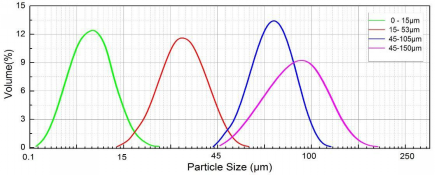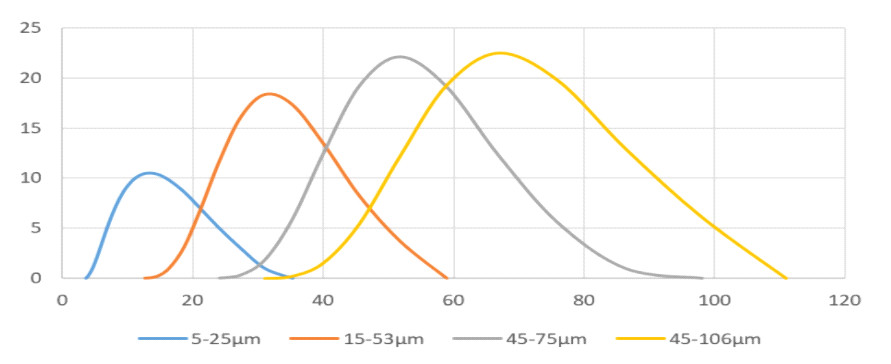Product Code : 3D-FeMnCoCr-CU-PO5
High-entropy alloys (HEAs) are alloys that are formed by mixing equal or relatively large proportions of (usually) five or more elements. Prior to the synthesis of these substances, typical metal alloys comprised one or two major components with smaller amounts of other elements. For example, additional elements can be added to iron to improve its properties, thereby creating an iron-based alloy, but typically in fairly low proportions, such as the proportions of carbon, manganese, and others in various steels. Hence, high-entropy alloys are a novel class of materials. The term "high-entropy alloys" was coined by Taiwanese scientist Jien-Wei Yeh because the entropy increase of mixing is substantially higher when there is a larger number of elements in the mix, and their proportions are more nearly equal. Some alternative names, such as multi-component alloys, compositionally complex alloys and multi-principal-element alloys are also suggested by other researchers. Alloys that have been maturely melted include W, Ta, Mo, Nb, V, Cr, Zr, Ti, Hf, and other metals with equal atomic ratios and non-equal atomic ratios in high-entropy alloys. Ordinary components of Co, Cr, Fe, Ni, Cu, Al can be melted and cut by high entropy alloy of various systems according to the customer requirements of components, and processe These alloys are currently the focus of significant attention in materials science and engineering because they have potentially desirable properties.
Please contact us if you need customized services. We will contact you with the price and availability in 24 hours.
| Product | Product Code | Purity | Size | Contact Us |
Product Information
High-entropy alloys (HEAs) are alloys that are formed by mixing equal or relatively large proportions of (usually) five or more elements. Prior to the synthesis of these substances, typical metal alloys comprised one or two major components with smaller amounts of other elements. For example, additional elements can be added to iron to improve its properties, thereby creating an iron-based alloy, but typically in fairly low proportions, such as the proportions of carbon, manganese, and others in various steels. Hence, high-entropy alloys are a novel class of materials. The term "high-entropy alloys" was coined by Taiwanese scientist Jien-Wei Yeh because the entropy increase of mixing is substantially higher when there is a larger number of elements in the mix, and their proportions are more nearly equal. Some alternative names, such as multi-component alloys, compositionally complex alloys and multi-principal-element alloys are also suggested by other researchers. Alloys that have been maturely melted include W, Ta, Mo, Nb, V, Cr, Zr, Ti, Hf, and other metals with equal atomic ratios and non-equal atomic ratios in high-entropy alloys. Ordinary components of Co, Cr, Fe, Ni, Cu, Al can be melted and cut by high entropy alloy of various systems according to the customer requirements of components, and processe These alloys are currently the focus of significant attention in materials science and engineering because they have potentially desirable properties
FeMnCoCr High-Entropy Alloy (HEA) Spherical Powder Particle Size
0-45um,0-53um,15-45um, 15-53um, 45-105um (Various granularities can be customized according to customer requirements).
FeMnCoCr High-Entropy Alloy (HEA) Spherical Powder Applicable processes
-Laser/electron beam additive manufacturing (SLM/EBM)
-Injection molding (MIM)
-Hot isostatic pressing (HIP)
-Powder metallurgy (PM)
-Spraying (SP) and other processes.
FeMnCoCr High-Entropy Alloy (HEA) Spherical Powder Application
FeMnCoCr High-Entropy Alloy (HEA) Spherical Powder is widely used in aerospace parts and auto parts, profile surface spraying, powder metallurgy, nuclear energy and industrial fields.
High-Entropy Alloys Manufacture
High-entropy alloys are difficult to manufacture using extant techniques , and typically require both expensive materials and specialty processing techniques. High-entropy alloys are mostly produced using methods that depend on the metals phase – if the metals are combined while in a liquid, solid, or gas state. Most HEAs have been produced using liquid-phase methods include arc melting, induction melting, and Bridgman solidification. Solid-state processing is generally done by mechanical alloying using a high-energy ball mill. This method produces powders that can then be processed using conventional powder metallurgy methods or spark plasma sintering. This method allows for alloys to be produced that would be difficult or impossible to produce using casting, such as AlLiMgScTi. Gas-phase processing includes processes such as sputtering or molecular beam epitaxy (MBE), which can be used to carefully control different elemental compositions to get high-entropy metallic or ceramic films. Additive manufacturing, can produce alloys with a different microstructure, potentially increasing strength (to 1.3 gigapascals) as well as increasing ductility. Other techniques include thermal spray, laser cladding, and electrodeposition.
FeMnCoCr High-Entropy Alloy (HEA) Spherical Powder Particle Size Description
· 0-15μm (D10=3~5μm, D50=6~10μm, D90=12~14μm)
· 5-25μm (D10=5~10μm, D50=15~20μm, D90=20~25μm)
· 15-45μm (D10=15~20μm,D50=25~30μm,D90=35~40μm)
· 15-53μm (D10=15~20μm,D50=25~35μm,D90=45~50μm)
· 45-75μm (D10=45~55μm,D50=55~65μm,D90=70~75μm)
· 45-105μm (D10=50~60μm,D50=75~85μm,D90=95~105μm)
· 45-150μm (D10=55~70μm,D50=110~120μm,D90=140~150μm)
· 75-150μm (D10=80~90μm,D50=110~125μm,D90=135~150μm)


Packing of FeMnCoCr High-Entropy Alloy (HEA) Spherical Powder
Standard Packing:
Typical bulk packaging includes palletized plastic 5 gallon/25 kg. pails, fiber and steel drums to 1 ton super sacks in full container (FCL) or truck load (T/L) quantities. Research and sample quantities and hygroscopic, oxidizing or other air sensitive materials may be packaged under argon or vacuum. Solutions are packaged in polypropylene, plastic or glass jars up to palletized 440 gallon liquid totes Special package is available on request.
ATTs’ FeMnCoCr High-Entropy Alloy (HEA) Spherical Powder is carefully handled to minimize damage during storage and transportation and to preserve the quality of our products in their original condition.
High-Entropy Alloys Species
| FeCoNiCr | NbMoTaW |
| CoCrFeNiMn | TiZrHfNbMo |
| AlCrFeCoNi | TiZrHfVMo |
| AlCoCrFeNi | TiZrVNbMo |
| FeMnCoCr | ZrVMoHfNb |
| TiZrHfVNb | WMoTaZr |
| TiNbMoTaW | TiZrTaMoNb |
| CuAlTiWV | CuAlTiVW |
| CoCrFeNiMo | NbMoTaWAl |
| TiVAlCrZr | TiZrVTa |
| FeNiCrCuAl | FeCoNi(AlSi)0.2 |
| CoCrFeNiV | Al1Mo0.5Nb1Ta0.5Ti1Zr1 |
| AlZrNbMo | Al4TiVFeSc |
| CrMnFeCoNi | Al4TiVFeGe |
| CoCrNiAl | Al4TiVFeCr |
| CoCrFeNiCu | CoCrFeNiTi |
| CoCrFeNiAl | CoCrFeNiCu |
| ZrMoCrNb | CoCrFeNiMo |
| TaHfZrTi | CoCrNiAlTi |
| AlCrFeCuNi | FeCrCoAlTi |
| AlFeNiCoCr | TiZrVTaMo |
| TiZrHfVTa | ZrTiHfNbMo |
| High-entropy Alloy Powder List | |
| Al0.5CoCrFeNi Powder | AlCoCrFeNi2.1 Powder |
| Al1.8CrCuFeNi2 Powder | NbMoTaW Powder |
| Al0.5CoCrFeNi Powder | NbMoTaWAl Powder |
| Fe50Mn30Co10Cr10 Powder | TiZrVTa Powder |
| FeCoNiCrAl Powder | FeCoNi(AlSi)0.2 Powder |
| CrMnFeCoNi Powder | Al1Mo0.5Nb1Ta0.5Ti1Zr1 Powder |
| Al4TiVFeSc Powder | CrFeCoNi Powder |
| Al4TiVFeGe Powder | CoCrNi Powder |
| Al4TiVFeCr Powder | CoCrFeNiMn Powder |
| NbMoTaWV Powder | CoCrFeNiMo Powder |
| AlCoCrFeNi Powder | |